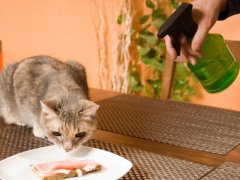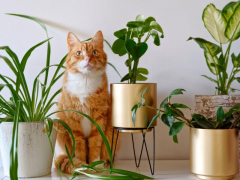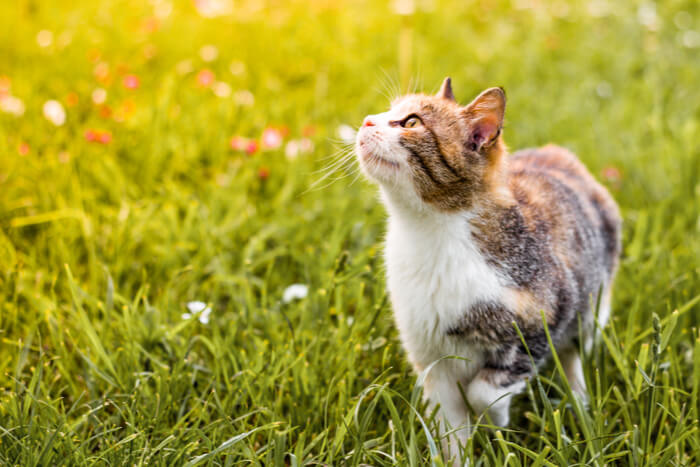
Many experts recommend keeping cats indoors to protect them from the dangers of the outdoors. Staying inside may help to keep cats safe, but some cat owners worry that an indoor-only lifestyle might be too restrictive. Let’s examine the pros and cons of letting your cat outside, and why staying inside is the safest option for most cats.
Outdoor Risks for Cats
The outside world poses many dangers to cats, whether related to human activity, other animals, or the environment. Outdoor cats even have a shorter life span than their indoor-only counterparts.
Some common hazards for outdoor cats include:
- Predators/wild animals (coyotes, wolves, hawks, owls, and other dangerous wildlife)
- Poisoning (slug and snail bait, rodenticides, herbicides, fertilizer, antifreeze, and other poisons)
- Animal traps
- Hit by car
- Theft by humans
- Being harassed or abused by humans or other animals
- Cat fights
- Injuries (falls, eye injuries, torn nails, etc.)
- Wandering off or becoming lost
- Parasites like fleas, ticks, and intestinal parasites
- Infectious disease from other cats or wildlife, including feline leukemia virus (FeLV), feline infectious peritonitis (FIP), feline distemper, feline immunodeficiency virus (FIV) and rabies
- Exposure to bad weather and temperature extremes (heat stroke and hypothermia)
Impact on Wildlife
Letting cats roam outdoors puts them at risk of injury, illness, and even death, but there’s another cost to letting cats outside: wildlife predation. Although most pet cats have little need to hunt for food, many domestic cats will hunt for fun or exercise, which can have a devastating effect on local wildlife populations. According to one study, free-ranging domestic cats were estimated to kill 1.3 to 4 billion birds and 6.3 to 22.3 billion mammals (mice, shrews, voles, squirrels and rabbits) every year.
Also Read: What To Do If Your Indoor Cat Gets Outside
Cons of Keeping Cats Indoors
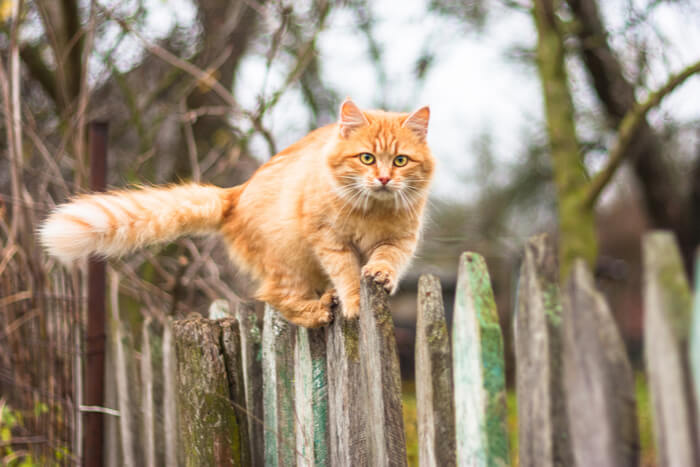
Cats that go outdoors naturally get more exercise as they explore, but you must weigh the benefits against the risks of roaming outside.
After reading that long list of potential outdoor dangers, it might seem like a no-brainer to keep your cat strictly indoors so you can keep them safe.
But a life entirely inside can bring hardships to cats, including the following:
- Boredom
- Lack of exercise
- Weight gain or obesity
- Inability to express natural behaviors like hunting, climbing, scratching
- Lack of mental stimulation
- Excessive meowing/yowling
- Stress, anxiety, or depression
- Behavior problems (urine marking, little box avoidance, destructive scratching)
- Fighting amongst household cats
- Aggression toward humans
The biggest issues for indoor-only cats are lack of mental stimulation, lack of exercise, and the inability to express the natural behaviors that make a cat a cat. This can cause cats to become bored, stressed, and depressed.
Bored cats often lie around much of the day, and the most exciting thing to do is visit the food bowl over and over for a snack. Inactivity and overeating lead to weight gain, which can contribute to health problems like diabetes and arthritis.
Stressed and depressed cats might develop behavioral issues like litter box issues, destructive scratching, fighting with other family pets, or even aggression toward humans.
Also Read: 5 Visual Signs of a Stressed Cat and How to Help
Pros of Letting Cats Outside
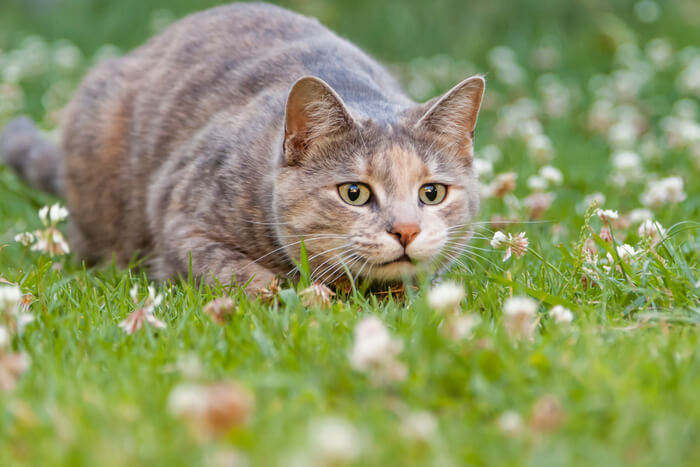
Cats that go outside enjoy the freedom to express natural behaviors, but it’s best to let cats enjoy the outdoors from a safely enclosed area or harness and leash.
The American Association of Feline Practitioners maintains a position statement regarding the indoor/outdoor debate, recognizing that although inside is safer, allowing your cat to explore outside can provide some pretty significant benefits to their physical and mental health.
Some of those benefits include:
- Exercise: Cats that go outside run, climb, scratch, and play. This means they get more exercise, which provides lots of healthy physical stimulation, and also wards off unwanted weight gain.
- Expressing natural behaviors: Although owned cats don’t need to hunt for their food, being outside with leaves blowing in the wind triggers your cat’s instincts to stalk, pounce, and chase. Cats also do a lot more climbing, scratching, and exploring.
- Mental stimulation: Being outside is just plain interesting! Cats find so much to see, smell, hear and touch, from grass to children playing to birds flying overhead and squirrels running through the yard. Even simply dozing in the sun and feeling the breeze ruffling their fur is more stimulating for your cat than resting inside.
- Overall reduction of stress and behavior problems: When a cat is active, stimulated, and allowed to express her natural instincts, they are happier and more content, which leads to fewer stress-related behavior problems.
Best of Both Worlds
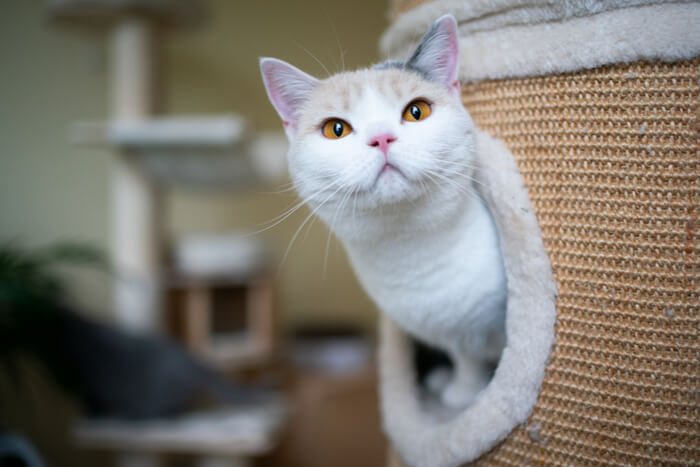
Give your cat lots of places to climb, perch and hide to enrich their indoor environment.
The bottom line: Staying indoors is safer for your cat. Luckily, there are many ways to keep an indoor-only cat both happy and safe. Environmental enrichment can encourage your cat to exercise and explore inside your home. Try cat trees for climbing and perching. Put them in front of windows so your cat can climb up and watch the goings-on outside.
Some cat owners install wall ramps for cats to traverse and climb. Introduce different types of scratchers so your cat has plenty of opportunities for “approved” scratching. For variety, offer both horizontal and vertical scratching posts of different materials (carpet, sisal, and cardboard).
Engaging your indoor cat in playtime is an excellent way to provide mental stimulation and exercise. Try playing with cat toys like feather wands, tossing jingle bell balls or catnip-filled toy mice, or having a chase and pounce session with a laser pointer (just be sure not to aim the beam near your cat’s eyes). Automatic toys that spin or roll can entice almost any cat to play.
Puzzle toys that require your cat to work and use their brain to get to the treats inside are highly stimulating. Treat-dispensing toys that must be batted around to release their goodies provide both exercise and mental stimulation.
Feeding your cat meals from puzzle toys or treat-dispensing toys can help mimic the hunting and foraging behaviors they don’t usually get to express. Plant some cat grass so your cat can enjoy nibbling.
Also Read: The 10 Best Cat Slow Feeders & Puzzle Feeders
How to Let Your Cat Safely Enjoy the Outdoors
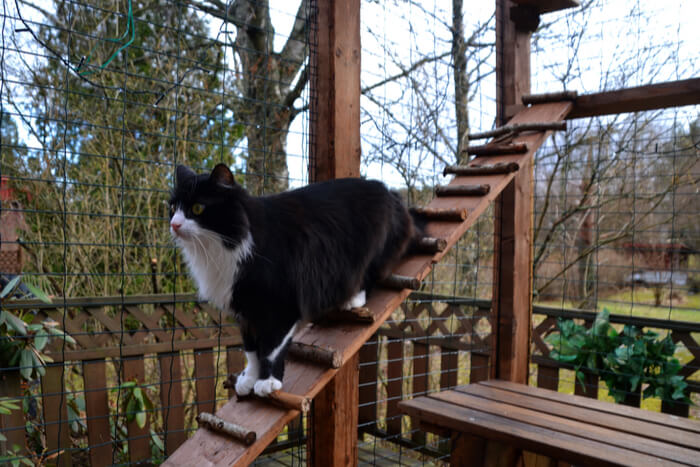
A “catio” is an enclosure that allows your cat to safely enjoy being outside.
There are ways to allow your cat to spend time outside while staying safe. Consider these ideas for cats to experience outdoor time without any risk to their safety:
- Buy or build a “catio”: A secure enclosure in your yard or on your patio can allow cats to get some fresh air and see, smell and hear the great outdoors while protecting them from harm. Catios may be large and elaborate, with many different perches, or as simple as a large wire dog crate. Be sure your cat always has access to shade and water when they are hanging out in a catio.
- Let your cat explore your safely fenced yard: A tall fence can keep your cat in your yard and deter predators from gaining access. To keep a better eye on them and to deter hunting birds and other wildlife, stay outside with your cat while they’re outside.
- Try leash walks or stroller walks: Many cats can learn to wear a harness and go for leashed walks in your neighborhood. Make sure your cat is comfortable and happy with this arrangement—walks should not be stressful. Ensure the harness fits snugly so your cat can’t slip out, and keep your eye open for loose dogs or stray cats that might approach (pick your cat up if you see any danger). Some cats hate harnesses but enjoy walks in an enclosed cat stroller. They can take in the sights while remaining safe and snug inside.
Safety First
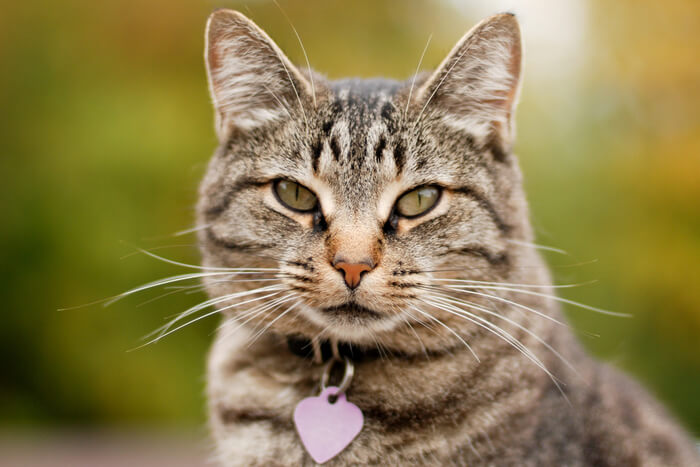
All cats should be microchipped and wear a collar and ID tag in case they ever get outside.
Most indoor-only cats will occasionally make it outside, so take some precautions to ensure your cat stays safe.
- Identification: Make sure your cat has a microchip and is always wearing a collar and ID tag with up-to-date contact information. GPS collars are an outstanding tech gadget that allows you to keep tabs on your cat if they escape.
- Preventive care: Keep your cat on year-round broad-spectrum parasite prevention that treats and controls fleas, ticks, heartworm, and intestinal parasites. Also, make sure your cat stays up to date on all their vaccinations (let your veterinarian know if your cat goes outside).
- Shelter: If your cat will be outdoors alone in a catio, make sure they have access to shade, shelter from rain and other weather, food, and water, or ensure that they can enter the house through a pet door.


